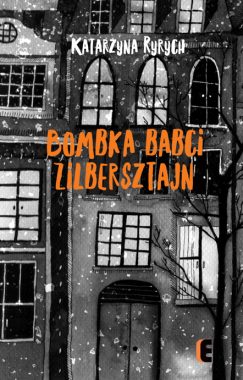Author: Katarzyna Ryrych
Illustrator: Anna Rudka
Year: 2018
Publisher: EZOP
Place of publication: Warszawa
Pages: 155
ISBN: 9788365230201

Ninka along with her parents and older brother Alek moves into an apartment where her recently deceased grandmother used to live. The apartment, located in an old tenement house, hides many secrets which are further exaggerated by the girl’s imagination. At one point, Ninka’s relationship with her brother and parents weakens. The only person who still has time for Ninka is Grandma Zilbersztajn, an elderly woman who lives upstairs and still remembers wartime. Around Christmas, she presents Ninka with an old, hand-painted bauble, which is later hung on the Christmas tree with other decorations. On the same day, Ninka discovers a secret passage hidden behind coats in a bedroom wardrobe. There is a hungry, scared little girl waiting for Ninka on the other side, and she does not want to reveal her name. Ninka continues to visit the world “on the other side of the wall”, learning new details about the tenement house and Grandma Zilbersztajn’s story. It turns out that the journey through the wall leads her to the past, to the time of the Holocaust.
Katarzyna Ryrych’s novel follows the trend in children’s literature to describe the Holocaust indirectly. Similarly to Joanna Fabicka’s Rutka, this novel explores the motif of spreading testimonies of war experiences from woman to woman, and shows the mechanisms of memory transmission. The girl from behind the wall involves Ninka in a game, making her lose awareness of the space she belongs to – whether past or present. The game trope leads to questions on the randomness of death, especially during the Holocaust. On the other hand, it suggests that abiding rules (such as quiet behavior in a hideout or concealing one’s identity) can help win the game, that is: to survive. Unfortunately, as Ryrych shows, bystanders often benefitted from someone’s loss in the game. She contributes to the social and political discussion on Poles’ participation in the Holocaust by alluding to the appropriation of former Jewish property by looters.
Bibliography:
- Karczewska, A., „Tylko czy niebo nadal istnieje?” Bóg w najnowszej dziecięcej literaturze o Zagładzie, [in:] Wiara i niewiara. Literackie realizacje wobec doświadczenia Zagłady, eds. P. Kalwiński, A. Karczewska, Lublin 2018, pp. 69–88 (p. 71 fn. 7, p. 73 fn. 12);
- Karczewska, A., Pamięć i empatia. O dziecięcej literaturze Zagłady, [in:] Pamięć o Zagładzie w polskojęzycznej i niemieckojęzycznej literaturze autorek i autorów drugiego oraz trzeciego pokolenia post-Szoah / Das Gedächtnis an die Shoah in der polnischen und deutschsprachigen Literatur von Autorinnen und Autoren der zweiten und dritten Post-Shoah-Generation, eds. I. von der Lühe, S.J. Żurek, Lublin 2019, pp. 265–300;
- Rybak, K., „Grandma Zilbersztajn’s Christmas Bauble [Bombka babci Zilbersztajn]”, Our Mythical Childhood Survey;
- Rybak, K., Dzieciństwo w labiryncie getta. Recepcja mitu labiryntu w polskiej literaturze dziecięcej o Zagładzie, Warszawa 2019 (p. 15, 76);
- Rybak, K., Stosunki polsko-żydowskie i Zagłada w polskiej literaturze dziecięcej XXI wieku, [in:] Stosunki polsko-żydowskie, vol. 2, Kultura. Literatura, sztuka i nauka w XX wieku, ed. Z. Trębacz, Warszawa 2020, pp. 171–187;
- Rybak, K., Zagłada i ideologia w polskiej literaturze dziecięcej XXI wieku, „Narracje o Zagładzie”, no. 1(7), 2021, pp. 155–173 (p. 164);
- Rybak, K., Obrazowanie Zagłady. Narracje holokaustowe w polskiej literaturze XXI wieku dla dzieci i młodzieży, Warszawa 2023.